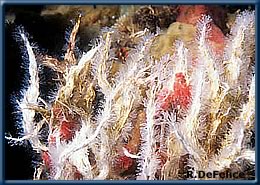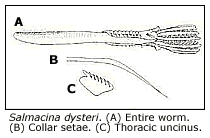

Chaetopterus sp.

Sabellestarte spectabilis

Salmacina dysteri
Salmacina dysteri
 Serpulid
worm
Serpulid
worm
Phylum Annelida
Class Polychaeta
Family Serpulidae
Description
This small gregarious species is characterized by having very slender,
white tubes, 15 mm long and 0.5 mm wide. Aggregations of this species
can form thick anastomosing bundles of tubes. The branchial crown is composed
of 8 radioles, 4 on each side. Species in this genus lack an operculum.
There are 7 to 9 thoracic segments; fin and blade setae occur on the first
setiger and simple wingless setae and sickle setae are present on the
remaining setigers (from Bailey-Brock 1987).
Habitat
 Most
common on hard substrates or overgrowing other fouling invertebrates in
sheltered waters, especially harbors and embayments, but can be found
in a variety of shallow and deep reef habitats.
Most
common on hard substrates or overgrowing other fouling invertebrates in
sheltered waters, especially harbors and embayments, but can be found
in a variety of shallow and deep reef habitats.
Distribution
Hawaiian Islands
Throughout the main islands, especially in harbors.
Native Range
Unknown
Present Distribution
Cosmopolitan in warm seas
Mechanism of Introduction
Unintentional, most likely as fouling on ships hulls
Impact
Fouling organism. Ecological impact unstudied, but assumed to be minimal.
Ecology
Reproduction
These worms may reproduce asexually by transverse division. They are also
hermaphroditic, and fertilization and subsequent larval development are
external.
Feeding
Serpulids are suspension feeders. Cilia on the tentacles create a current
that draws water and food particles to the worm. The particles are captured,
sorted, and carried with mucus along a series of tracts and grooves to
the mouth.
Remarks
Although nomenclatural problems surround this now-global species, we tentatively
retain this name. This signature fouling harbor species is also reported
in Hawaiian waters at depths to 200-600 meters and as being found across
a wide variety of habitat facies in the Islands, for example, rocky intertidal,
reef flats on algae, anchialine lava ponds, and reef slopes to depth (Bailey-Brock,
1976). While it may thus be that more than one species is involved, this
range of habitats tentatively places this tubeworm in the cryptogenic
category.
Edmondson and Ingram (1939) found it in fouling beginning in 1935 in Kaneohe
Bay. Long (1974) reported it on "offshore" and Pearl Harbor
fouling panels (1968), and Hartman (1966) noted that it occurred as "massed
tubes fouling harbor installations during summer and fall months at Pearl
Harbor and Kaneohe Bay". It's continued presence has been widely
reported throughout the main islands by numerous authors.
References
Bailey-Brock, J.H. 1976. Habitats of tubicolous polychaetes from the Hawaiian
Islands. Pacific Science. 30:69-81.
Edmondson, C.H. and Ingram, W.H. Fouling organisms in Hawaii. B.P. Bishop
Mus. Occ. Pap. 14(14):251-300.
Hartman, O. 1966. Polychaetous annelids of the Hawaiian Islands. Occ.
Pap. B.P. Bishop Mus. 33(11): 163-252.
Long, E.R. 1974. Marine fouling studies off Oahu, Hawaii. Veliger. 17:
23-39.
© 2002 Hawaii Biological Survey, Bishop Museum
contact